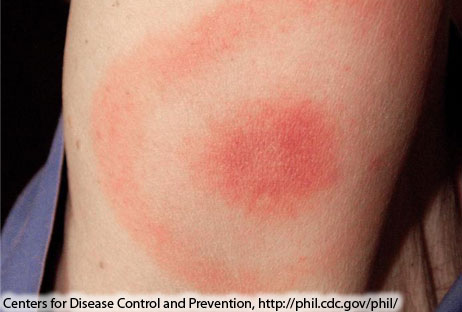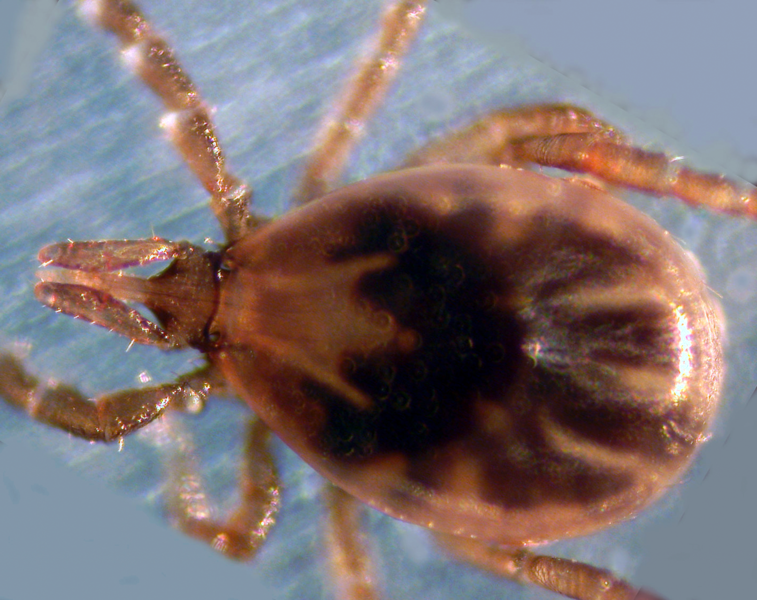Sandbox : anmol: Difference between revisions
Jump to navigation
Jump to search
No edit summary |
No edit summary |
||
| Line 8: | Line 8: | ||
* [[Lyme disease]] is a condition commonly caused by bite of a [[tick]] infected with [[Borrelia burgdorferi]]. | * [[Lyme disease]] is a condition commonly caused by bite of a [[tick]] infected with [[Borrelia burgdorferi]]. | ||
==What are the | ==What are the Symptoms of Lyme Disease?== | ||
{| | {| | ||
| | | | ||
| Line 31: | Line 31: | ||
[[Image:Classic Lyme disease rash.jpg|thumb|250px|center|Classic Lyme disease rash - [https://www.cdc.gov/lyme/signs_symptoms/rashes.html Source: CDC.gov]]] | [[Image:Classic Lyme disease rash.jpg|thumb|250px|center|Classic Lyme disease rash - [https://www.cdc.gov/lyme/signs_symptoms/rashes.html Source: CDC.gov]]] | ||
|} | |} | ||
*Late Signs and Symptoms (days to months after tick bite): | *'''Late Signs and Symptoms (days to months after tick bite):''' | ||
**Severe [[Headache (patient information)|headaches]] and [[Neck stiffness/pain (patient information)|neck stiffness]] | **Severe [[Headache (patient information)|headaches]] and [[Neck stiffness/pain (patient information)|neck stiffness]] | ||
***Multiple [[erythema migrans]] rashes on other areas of the body. | ***Multiple [[erythema migrans]] rashes on other areas of the body. | ||
| Line 51: | Line 51: | ||
*[[Ticks]] can spread other organisms that may cause a different type of [[rash]]. | *[[Ticks]] can spread other organisms that may cause a different type of [[rash]]. | ||
==What | ==What Causes Lyme disease?== | ||
* [[Lyme disease]] is caused by a [[bacterial infection]] you get from bite of an infected [[tick]]. | * [[Lyme disease]] is caused by a [[bacterial infection]] you get from bite of an infected [[tick]]. | ||
*The majority of [[Lyme disease]] in North America is caused by bite of [[Ixodes scapularis|black-legged tick]], or [[deer tick]] (''[[Ixodes scapularis]]''). | *The majority of [[Lyme disease]] in North America is caused by bite of [[Ixodes scapularis|black-legged tick]], or [[deer tick]] (''[[Ixodes scapularis]]''). | ||
| Line 61: | Line 61: | ||
|} | |} | ||
==Who is at | ==Who is at Highest Risk?== | ||
Individuals who spend time outdoors and/or have pets that go outdoors in [[Endemic (epidemiology)|endemic]] regions are at risk for [[tick-borne disease]]. | Individuals who spend time outdoors and/or have pets that go outdoors in [[Endemic (epidemiology)|endemic]] regions are at risk for [[tick-borne disease]]. | ||
* Exposure to ticks: | |||
**Individuals with frequent exposure to dogs and who reside near wooded areas or areas with high grass may also be at increased risk of [[tick-borne infection]]. | |||
**Individuals with outdoor occupations and who work outside with bare or exposed [[skin]] are at a high risk of contracting Lyme disease. | |||
**Failing to remove a [[tick]] as soon as you see it on your [[skin]] (the longer a [[tick]] is attached to your skin, the greater your risk of developing [[Lyme disease]]) also increases risk of developing Lyme disease. | |||
* Endemic Regions: | |||
* | **About 95% of all reported cases are confined to 14 states including Connecticut, Delaware, Maine, Massachusetts, Minnesota, New Hampshire, New Jersey, New York, Pennsylvania, Rhode Island, Vermont, Virginia, and Wisconsin. | ||
**Any individual traveling or living within these five geographic areas including New England, Mid-Atlantic, East-North Central, South Atlantic, and West North-Central is at a heightened risk of exposure to [[Lyme disease]]. | |||
* Seasonal Variation: | |||
* | **The majority of [[Lyme disease]] cases are reported during the summer months of May to August. | ||
* | **Case incidence increases in May, peaks in June and July, and tapers off in August. | ||
* Rarer forms of Transmission: | |||
** Cases of [[blood transfusion]] and [[organ transplantation]] have been recorded as methods of [[Transmission (medicine)|transmission]] but this is a rare mode of transmission. | |||
* | |||
* Cases of [[blood transfusion]] and [[organ transplantation]] have been recorded as methods of [[Transmission (medicine)|transmission]] but this is a rare mode of transmission. | |||
==Diagnosis== | ==Diagnosis== | ||
Following points should be taken into consideration in order to make a diagnosis of [[Lyme disease]]: | |||
*A history of exposure to potentially infected [[ticks]], especially in areas of the country known to have [[Lyme disease]]. | |||
*Symptoms, including physical findings such as the characteristic rash ([[erythema migrans]]). | |||
*Results of blood tests that check for [[antibodies]] to the [[bacterium]] that causes [[Lyme disease]]. | |||
==When to Seek Urgent Medical Care?== | |||
==When to seek | You should seek medical care if: | ||
*You are bitten by a tick. | |||
* | *You have a rash similar to erythema migrans (even if you donot remember tick bite). | ||
*After removal of tick with proper procedure. | |||
==Treatment | ==Treatment Options== | ||
*According to CDC, patients treated with [[antibiotics]] in the early stages of the infection usually recover rapidly and completely. | *According to CDC, patients treated with [[antibiotics]] in the early stages of the infection usually recover rapidly and completely. | ||
| Line 96: | Line 96: | ||
*Patients with certain [[neurological]] or [[cardiac]] forms of illness may require [[Intravenous therapy|intravenous]] treatment with drugs such as [[Ceftriaxone Sodium Injection (patient information)|ceftriaxone]] or [[penicillin]]. | *Patients with certain [[neurological]] or [[cardiac]] forms of illness may require [[Intravenous therapy|intravenous]] treatment with drugs such as [[Ceftriaxone Sodium Injection (patient information)|ceftriaxone]] or [[penicillin]]. | ||
==Where to find | ==Where to find Medical Care for Lyme Disease?== | ||
Medical care for [[Lyme disease]] can be found [https://www.google.com/maps/search/hospitals/ here]. | |||
==Prevention== | ==Prevention== | ||
| Line 116: | Line 115: | ||
**Save the [[tick]] for possible identification by a doctor or the local health department. | **Save the [[tick]] for possible identification by a doctor or the local health department. | ||
==What to expect | ==What to expect Prognosis?== | ||
*For early cases, prompt treatment is usually curative. | *For early cases, prompt treatment is usually curative. | ||
*However, the severity and treatment of Lyme disease may be complicated due to: | *However, the severity and treatment of Lyme disease may be complicated due to: | ||
Revision as of 18:02, 7 August 2017
To go back to Lyme disease main page, click here
Editor-In-Chief: C. Michael Gibson, M.S., M.D. [1]; Associate Editor(s)-in-Chief: Anmol Pitliya, M.B.B.S. M.D.[2]
Overview
- Lyme disease is a condition commonly caused by bite of a tick infected with Borrelia burgdorferi.
What are the Symptoms of Lyme Disease?
|
 |
- Late Signs and Symptoms (days to months after tick bite):
- Severe headaches and neck stiffness
- Multiple erythema migrans rashes on other areas of the body.
- Arthritis with severe joint pain and swelling, particularly the knees and other large joints.
- Facial palsy (loss of muscle tone or droop on one or both sides of the face).
- Intermittent pain in tendons, muscles, joints, and bones.
- Heart palpitations or an irregular heart beat (Lyme carditis).
- Episodes of dizziness or shortness of breath.
- Inflammation of the brain and spinal cord.
- Nerve pain.
- Shooting pains, numbness, or tingling in the hands or feet.
- Problems with short-term memory.
- Severe headaches and neck stiffness
Notes
What Causes Lyme disease?
|
 |
Who is at Highest Risk?
Individuals who spend time outdoors and/or have pets that go outdoors in endemic regions are at risk for tick-borne disease.
- Exposure to ticks:
- Individuals with frequent exposure to dogs and who reside near wooded areas or areas with high grass may also be at increased risk of tick-borne infection.
- Individuals with outdoor occupations and who work outside with bare or exposed skin are at a high risk of contracting Lyme disease.
- Failing to remove a tick as soon as you see it on your skin (the longer a tick is attached to your skin, the greater your risk of developing Lyme disease) also increases risk of developing Lyme disease.
- Endemic Regions:
- About 95% of all reported cases are confined to 14 states including Connecticut, Delaware, Maine, Massachusetts, Minnesota, New Hampshire, New Jersey, New York, Pennsylvania, Rhode Island, Vermont, Virginia, and Wisconsin.
- Any individual traveling or living within these five geographic areas including New England, Mid-Atlantic, East-North Central, South Atlantic, and West North-Central is at a heightened risk of exposure to Lyme disease.
- Seasonal Variation:
- The majority of Lyme disease cases are reported during the summer months of May to August.
- Case incidence increases in May, peaks in June and July, and tapers off in August.
- Rarer forms of Transmission:
- Cases of blood transfusion and organ transplantation have been recorded as methods of transmission but this is a rare mode of transmission.
Diagnosis
Following points should be taken into consideration in order to make a diagnosis of Lyme disease:
- A history of exposure to potentially infected ticks, especially in areas of the country known to have Lyme disease.
- Symptoms, including physical findings such as the characteristic rash (erythema migrans).
- Results of blood tests that check for antibodies to the bacterium that causes Lyme disease.
When to Seek Urgent Medical Care?
You should seek medical care if:
- You are bitten by a tick.
- You have a rash similar to erythema migrans (even if you donot remember tick bite).
- After removal of tick with proper procedure.
Treatment Options
- According to CDC, patients treated with antibiotics in the early stages of the infection usually recover rapidly and completely.
- Antibiotics commonly used for oral treatment include doxycycline, amoxicillin, or cefuroxime axetil (Ceftin).
- Patients with certain neurological or cardiac forms of illness may require intravenous treatment with drugs such as ceftriaxone or penicillin.
Where to find Medical Care for Lyme Disease?
Medical care for Lyme disease can be found here.
Prevention
- Educate yourself about Lyme disease, and try not to get bitten by ticks.
- More specifically:
- Avoid wooded, brushy, and grassy areas, especially in May, June, and July. (Contact the local health department or park/extension service for information on the prevalence of ticks in specific areas.)
- Wear light-colored clothing so that you can see ticks that get on you.
- Wear long pants and long-sleeved shirts.
- Wear shoes that cover the entire foot. Tuck pant legs into socks or shoes, and tuck shirts into pants.
- Wear a hat for extra protection.
- Spray insect repellent containing DEET on clothes and exposed skin other than the face, or treat clothes with permethrin, which kills ticks on contact.
- Walk in the center of trails to avoid brush and grass.
- Remove your clothing, and wash and dry them at high temperatures after being outdoors.
- Do a careful body check for ticks after outdoor activities.
- If a tick is attached to you, remove it!
What to expect Prognosis?
- For early cases, prompt treatment is usually curative.
- However, the severity and treatment of Lyme disease may be complicated due to:
- Late diagnosis
- Failure of antibiotic treatment
- Coinfection with other tick-borne diseases including Ehrlichiosis and Babesiosis
- Immune suppression in the patient
- Some patients with Lyme disease have fatigue, joint and/or muscle pain, and neurocognitive symptoms persisting for years despite antibiotic treatment.
- Patients with late stage Lyme disease have been shown to experience a level of physical disability similar to that seen in congestive heart failure.
- Though rare, Lyme disease can be fatal.
Possible complications
- Late Lyme disease can cause long-term joint inflammation (Lyme arthritis) and heart rhythm problems. Brain and nervous system problems are also possible, and may include:
- Decreased concentration
- Memory disturbances
- Nerve damage
- Numbness
- Pain
- Paralysis of the face muscles
- Sleep disorders
- Vision problems